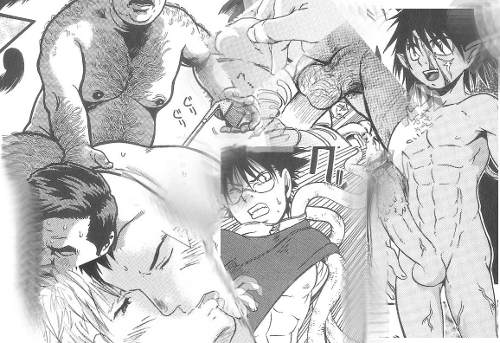Gay Manga 薔薇漫画

Manga historical background
Explicitly erotic art has a long history in Japan in the form of shunga, a category of ukiyoe (“floating world”) woodblock prints. Shunga, originally from China, became popular in Japan in the Heian era. Shunga (春画 literally means “spring picture,” the season of spring being traditionally (and understandably) associated with things plumping, warming, firming, and moistening up, i.e. with things erotic.
The best of the ukiyoe artists produced shunga, probably as much for the financial rewards as anything else. Besides being sexually explicit, shunga have always been notable for frequently dealing with the quirkier side of sexuality, the most famous example being the 19th century Hokusai‘s Tako to ama “Octopi and Female Diver” (usually mistranslated into English as “The Dream of the Fisherman’s Wife.”) It depicts a woman amid the waves having cunnilingus performed on her by one octopus and being kissed, and a nipple caressed, by another, in the slithery and suckered embrace of no less than 16 serpentine arms.
While not considered particularly quirky in pre-modern Japan, homosexuality is another theme that is amply dealt with — mainly male-on-male — as well as masturbation.
Another feature of shunga is the exaggerated size of sexual organs: the penis even more than the vagina. The penis is generally improbably huge, somewhat grotesquely shaped and prominently veined, and darker and more intricately detailed than the rest of the man’s body.
Types of gay manga
Against this historical backdrop of explicit, exaggerated, unconventional (to the Western viewer) depictions of sex enters the modern manga, or comic. Manga is a huge genre covering multiple sub-genres. They range from the Japanese equivalent of cutesy Disney-style comics for elementary school age, to R18, no-holds-barred fantasy free-for-alls of the freakiest — and usually the most violent — sexual scenarios imaginable. The latter kind are typified by dōjinshi — small-print-run, often self-published, hobbyist works that sexually and often violently parody mainstream manga.
It is only natural that gay manga form a manga sub-genre of their own. And it is only natural that they share many of the same features that have historically characterized erotic art in Japan.
The gay manga genre is known as bara, or rose, which is a general term for things gay in Japan. The term menzu rabu (men’s love) is also sometimes encountered.
Gay manga history
The bara manga became popular in the 1960s and are predominantly fetishistic. The pioneer in this genre was a fetish magazine called Fuzokukitan, which ran throughout the 1960s and early 1970s. Gay one-shot manga were included among the many other genres — one shot meaning a short self-contained chapter-length manga, as opposed to serialized or novel-style. Soon exclusively gay magazines took over, the most famous being the long-running but now defunct Barazoku (literally, “rose tribe”) magazine.
Gay manga content
Among the protagonists or props that fuel gay manga fantasies are men in uniform such as policemen, prison guards, soldiers, etc., bosses and subordinates, sportsmen, foreigners, and monsters. Machismo is taken to (or beyond) the limit in almost inevitable violence of a semi-sexual or explicitly sexual nature. The penis is everywhere. However, in contrast to the regularly gargantuan organs seen in shunga, penises in bara manga are not necessarily oversized. It depends largely on the artist. For example, the wildly macho style of the legendary manga artist Gengoro Tagame features very ripped bodies but with cocks kept in proportion, and the gachi muchi (“muscle chubby”) men in manga by the artist Kujira (literally “Whale”!) are endowed quite small in relation to their bulk — although there is no scarcity of mind-bogglingly big, all the same. Sometimes the depiction of penis seems consciously modelled on shunga, with exaggerated length, darkness, veininess and bulbousness.
Instruments of sexual incursion are as variable as the scenario involved, from relatively benign fingers to dildos, sticks of bamboo, candles and golf clubs (the latter three examples being from stories involving samurai and golfers, respectively).
Gay manga storylines
The stories of gay manga always involve an unequal power relationship, where sex is the means of domination. The power wielder is the tachi (“tah-chee,” top) and the receiver the uke (“oo-kay,” bottom). They range from realistic to the fantastic, with various measures of each in the same manga. Sometimes the sex is explicitly about bonding, at other times it seems like gratuitous violence. There are soft gay manga, or yaoi, originally produced for a female readership rather than for gay men. Yaoi are about boys falling in love and, at their most explicit, coyly ejaculating to soft moans and kisses. Then at the opposite extreme there are hard historical manga portraying page after page of epic sexual torture, held together by a very threadbare plot.
Junichi Yamakawa
Going by popularity, perhaps the most typical gay manga stories are those told by the famous gay manga artist, Junichi Yamakawa, that appeared for many years in Barazoku.
Yamakawa’s one-shot stories featured a fairly even balance of social and sexual interaction. The basic simplicity, naivety and punchiness of his stories, the classic, straightforward cartoon drawing, and especially the distinctive vocabulary that his characters employed has popularized his work in a retrospective come-back that extends well beyond the gay scene.
Gay manga are a testament to the extraordinary degree of sexual freedom enjoyed in Japan. The number of them and the speed with which individual manga go out of print to be replaced by others indicates, too, the size of Japan’s gay sector and its ongoing demand for new stimulation through a style of publication — the manga — that has kept the Japanese entertained for centuries.
Buy gay manga from GoodsFromJapan